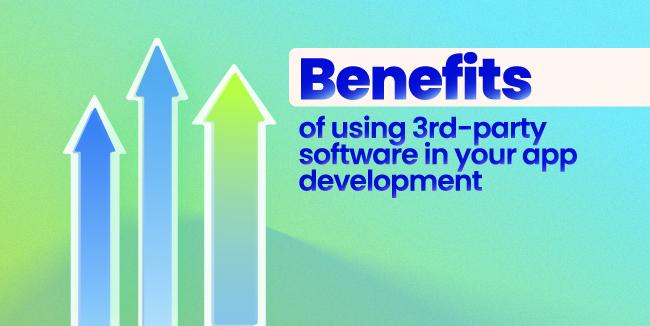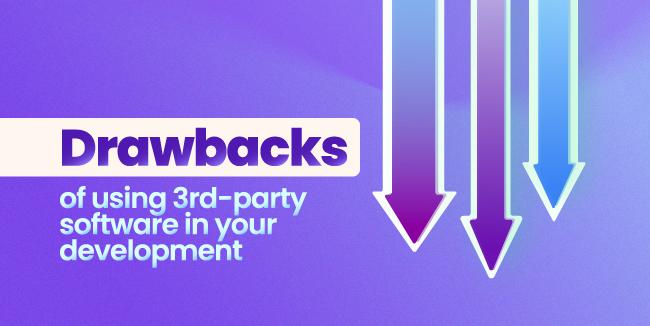

Custom mobile app development from the ground up takes a long time and work. That is why developers today use many tools, libraries, and platforms to minimize the need to reinvent the wheel and create common features from scratch.
If you're unsure about whether or not to use third-party software during the development process, look no further. In this article, you'll learn everything there is to know about third-party software - from the pros and cons of using it to expert recommendations from developers from the best product development company.
A third-party app is developed by a third party, not the device it runs on or the website or app that provides it. Although this isn't standard usage, you might think of them as first-party applications (we'll use it in this post to make things clear).
The device or website owner can enable or disable third-party applications by default. The Safari web browser app preinstalled on the iPhone is a first-party, built-in program produced by Apple. Still, other web browser apps available in the App Store have been authorized for usage on the iPhone but were not created by Apple. Apps from a variety of sources are available. These applications are third-party applications.
Third-party software is any software that can be used without affecting the primary product. It's supplied or produced for a certain purpose by a different firm/individual from the one that created the current product on a particular system.
There are several situations where you may run into the term "third-party app."
There are numerous strategies to work with third-party solutions. Here's a look at the most frequent kinds of third-party software:
For example, SnapKit and Moya libraries for iOS or Lottie, Android library.
For example, Firebase, Auth0, Google Maps Platform.
For example, SiwftLint, Danger, Zeplin.

When you use 3rd-party software carefully to enhance the app development process, increase the quality of the product, and cut costs.
If you use a third-party solution, you pay a monthly fee rather than the initial up-front cost for creating the feature from the ground up. Learn what other aspects influence the cost of your project with our " Software development costs - everything you need to know + Free Estimation " article!
Developers don't have to start from scratch. They may concentrate on the app's most essential features and competitive advantages. It drastically reduces the time it takes to create an app.
Using third-party services has a significantly lower price tag. Some third-party platforms may be free until a certain threshold is reached. After that, you're likely to pay a monthly charge for the utilized resources. As a result, the expense of using a function is spread out over time.
You might be able to get your product to market faster by accelerating the development process.
You may quickly check whether your concept solves the problem of your target consumers and whether it fulfills the requirements for a successful product/market fit.
Modern SDKs are available on many platforms now, making integration quick and straightforward. There's less work for you to do
A third advantage of utilizing a third-party platform is that there is no need to maintain the code. This duty belongs to the provider, not the company that utilizes the service. Such a provider can be an offshore outsourcing company specializing in a given field of development.

When working with a third-party solution, you are limited by the provider's features and functionality. If you need to make changes or enhancements to the app, you must go through the provider. We usually have to work hard to adapt the provider's tool to our demands. Developers can do that, but it gets too expensive at some point.
You're usually reliant on the supplier of a third-party solution. It exposes your software to danger. That is why it's typical to start from scratch and utilize third-party solutions for only non-core elements in your core apps.
Also, depending on the provider means that when the price of the service changes, so might the application's expenses. It's not unusual for third-party solutions to have significant increases in cost at a certain scale.
When a client approaches us with an idea for an app, we usually advise them to start with a simple MVP made by a trustworthy cross-platform mobile app development company. If you want to know more about an MVP, what is it and how it should be done right, we made an article “Build your MVP (Minimum Viable Product) the right way - step by step guide by mDevelopers”. After reading it you will know almost everything about Minimum Viable Product. MVP brings value to users. Following the agile methodology of software development, our teams focus on the essential elements of the app. All of the benefits we mentioned above – faster time-to-market, accelerated development process, and shorter feedback loop from users – means that third-party solutions are an excellent match for MVP development (for example, iOS and Android application).
About the author Peter Koffer - Chief Technology OfficerWith 13 years of experience in the IT industry and in-depth technical training, Peter could not be anything but our CTO. He had contact with every possible architecture and helped create many solutions for large and small companies. His daily duties include managing clients' projects, consulting on technical issues, and managing a team of highly qualified developers.